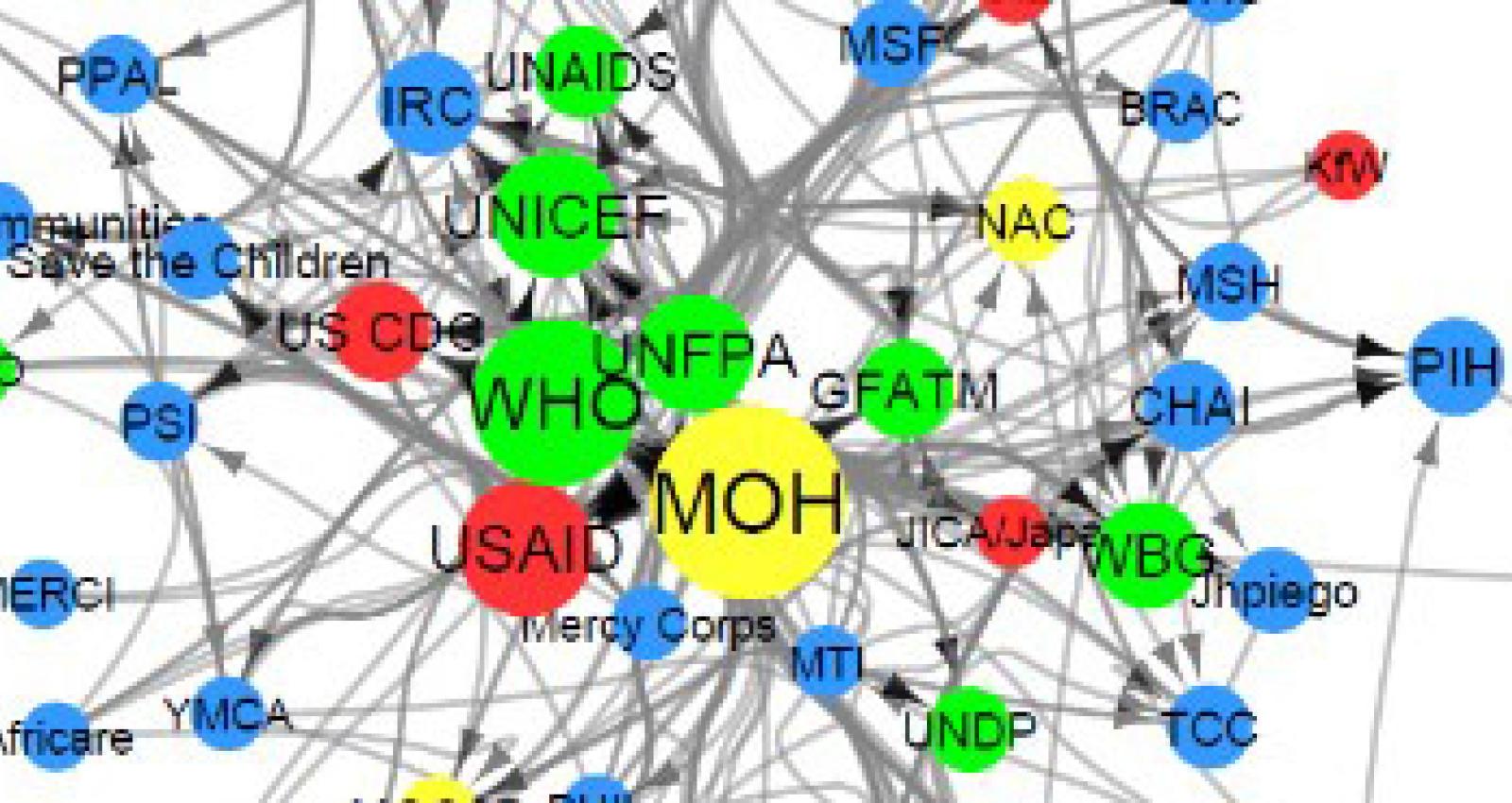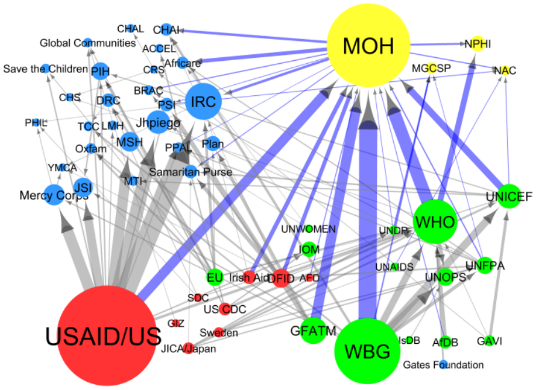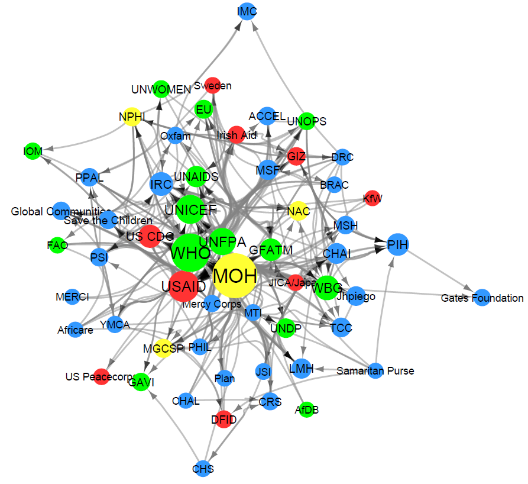Understanding the Role of the World Bank Group in a Crowded Institutional Landscape
Social Network Analysis is a particularly helpful method to better understand the role of a policy intervention in a world full of policy interventions.
Social Network Analysis is a particularly helpful method to better understand the role of a policy intervention in a world full of policy interventions.
By: Jos VaessenKatsumasa Hamaguchi
Social Network Analysis ... provides us with a visual representation of a complex institutional landscape that immediately provides us clear information on who the key institutional actors are, how they relate to each other, whether the system is well-integrated or not, and so on.
“You are not alone”, apart from being one of Michael Jackson’s relatively less well-known hit songs, is also an appropriate catch phrase for a pervasive cognitive bias that affects our thinking as development practitioners and evaluators. This bias can best be described as “intervention-centric” thinking; the tendency to see the world through the lens of the policy intervention that we are planning, implementing or evaluating. If we are not careful, it can lead us to overestimate the role of the policy intervention and underestimate the role of context. This applies to projects, programs, policies and strategies but also to organizations as whole.
Now, a good sense of realism and understanding of the context in which a specific policy intervention is embedded can certainly help to mitigate this bias, at least partially. Yet, most of our analytical tools for planning and evaluation, such as logical frameworks and program theories, are not particularly helpful in this regard. If anything, they only reinforce intervention-centric thinking by depicting causal linkages from the perspective of the intervention.
So how do we address this bias? A previous blog post in this series refers to some useful approaches to causal analysis that enable us to think about causal change from a systemic perspective (see also Williams and Hummelbrunner, 2011). Here, we look at a related question, how can we better understand the role of a policy intervention in a world full of policy interventions. Social Network Analysis is a particularly helpful method in this regard. It has been around for a while (the classic text book is Wasserman and Faust, 1994), but new developments in software have made it a very accessible technique for mapping and interpreting relations between entities or the system of entities as a whole.
In IEG we have used Social Network Analysis in a number of evaluations to bring in a more systemic institutional perspective into our analyses. Recently, we applied Social Network Analysis to better understand how the WBG (in this case mainly the World Bank) positions itself in the Health Sector in Liberia. We applied a standardized questionnaire to more than 50 organizations that constitute the universe of institutional actors supporting health systems and health services delivery in Liberia (according to certain criteria).
First, we tried to better understand the role of the WBG as a financier of the health system. The results are shown in the first figure. The size of the bubbles denotes the annual budget for health in the country. The color of the bubble denotes the types of organization (e.g. green for multilateral international organization). Among many other things, the figure clearly shows how the WBG is the second largest donor to the health sector and the primary donor supporting the sector through the budget of the Ministry of Health.

Second, we looked at the perceived knowledge leadership of different organizations in the health sector on the basis of a limited set of standardized questions and stratifying for topics (e.g. health systems, communicable diseases, etc.). The overall picture is shown in the figure below. It clearly shows how the Ministry of Health and WHO are regarded as the knowledge leaders at the national level, followed by USAID, UNICEF and UNFPA. The WBG features in the third tier of perceived knowledge leaders. This can be explained by the fact that the WBG does not have that many dedicated staff on health in the country and works mainly through the Ministry of Health.

Some caveats are in order and we briefly discuss the most important ones. First, the response rate on the face to face questionnaire was very high but not 100%. Ideally, Social Network Analysis requires data points on all relevant units of analysis, which was not possible in this case. Second, the picture shows a snapshot in time and institutional landscapes may quickly evolve. Finally, the network map is only as good as the underlying data. In this case, we asked a limited number of precise questions, as respondents needed to reflect on their relationship with the total universe of organizations active in the health sector. In addition, response effects may occur but were mitigated (inter alia) by using an external consultant.
Social Network Analysis can be applied using a variety of data sources (e.g. surveys, interviews, corporate data, online bibliometric data) and if applied rigorously can help us understand how the World Bank Group positions itself in relation to other institutional actors on strategic issues. Of equal importance is the fact that it provides us with a visual representation of a complex institutional landscape that immediately provides us clear information on who the key institutional actors are, how they relate to each other, whether the system is well-integrated or not, and so on.
Most importantly perhaps, Social Network Analysis can help expose deep-seated cognitive biases around the (perceived) positioning of the World Bank Group - such as in a particular sector, for example. In this “policy-saturated” world, it is good to continuously remind ourselves that we are not alone.
IEG (2017; forthcoming). An Evaluation of World Bank Group Support to Health-Care Services: Achievements and Challenges. Washington D.C.: Independent Evaluation Group, World Bank Group.
Wasserman, S. and K. Faust (1994). Social network analysis: Methods and applications. Cambridge: Cambridge University Press.
Williams, B. and R. Hummelbrunner (2011). Systems concepts in action: a practitioner’s toolkit. Stanford: Stanford University Press.


Comments
This is excellent use of…
This is excellent use of Social Network Analysis /Dynamic Systems Theory. It is also possible to use these tool for the analysis of conflict and fragility (see "The five Percent" by Coleman 2011).
Dear Camilo, thanks for your…
Dear Camilo, thanks for your interest in our blog post and for the reference.
Very interesting use of SNA…
Very interesting use of SNA. May I ask which tool you used and if you had any particular feedback about it (ease of use, challenges)?
Dear Florent, thanks for…
Dear Florent, thanks for your comment. We used Cytoscape an open source software. The challenges were mostly on the data collection side. Feel free to contact us via linkedin for further discussion.
Add new comment